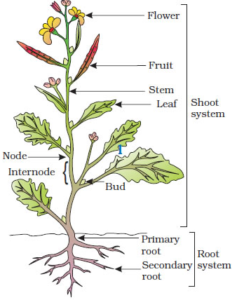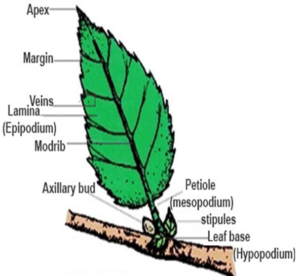Science > Biology > Botany> Morphology of Plants > The Leaf
The body of a typical flowering plant can be divided into the underground root system and aerial shoot system. The shoot system is heterogeneous. The shoot system (stem) is an aerial and erect part of the plant body that grows upwards. It is usually above the soil and develops from the plumule of the embryo of a germinating seed. It consists of a stem, branches, leaves, flowers, fruits, and seeds. In this article, we shall very important of a plant, the leaf.

The leaf is lateral, generally flattened structure borne on the stem. A leaf may be defined as “A dorsoventrally compressed, lateral appendage of the stem, produced at the nodes and is specialized to perform photosynthesis. It develops at the node and bears a bud in its axil. The axillary bud later develops into a branch. Leaves originate from shoot apical meristems and are arranged in an acropetal (outward) order. They are the most important vegetative organs for photosynthesis.
Characteristics of Leaf:
- The leaf is a thin, expanded, green structure. The green colour is due to the presence of chlorophyll pigment.
- An auxiliary bud is present at the axil of each leaf.
- It is borne on the stem at the node, hence it is exogenous.
- It does not contain apical bud required for continuous growth hence it has limited growth.
- The lamina possesses prominent vascular strands called veins.
- Leaf bears abundant stomata for the exchange of gases.
The Structure of the Leaf:

A typical leaf consists of three main parts: leaf base, petiole, and lamina. The leaf is attached to the stem by the leaf base (hypo-podium) and may bear two lateral small leaf-like structures called stipules. The leaves with stipules are called stipulate leaves and the leaves without stipules are called ex-stipulate leaves. The main functions of stipules are to protect the bud and carry out photosynthesis. In monocotyledons, the leaf base expands into a sheath covering the stem partially or wholly. In some leguminous plants, the leaf base may become swollen, which is called the pulvinus. It protects the young axillary bud.
The petiole (mesopodium) is a cylindrical or sub-cylindrical smooth or grooved stalk of the leaf which lifts the lamina above the level of the stem. Leaves that possess petiole are called petiolate leaves and those without petioles are called non-petiolate or sessile leaves. In papaya the petiole is hollow. The petiole help to hold the blade to light and also in conduction. Long thin flexible petioles allow leaf blades to flutter in wind, thereby cooling the leaf and bringing fresh air to the leaf surface.
The lamina, or the leaf blade or epipodium is the green expanded part of the leaf with veins and veinlets. There is, usually, a middle prominent vein, which is known as the midrib. Veins provide rigidity to the leaf blade and act as channels of transport for water, minerals and food materials. The shape, margin, apex, surface, and extent of incision of lamina varies in different leaves. The main functions of the lamina are photosynthesis and transpiration.
In dicots, the leaves are dorsiventral because its dorsal and ventral surfaces are structurally different. In monocots the dorsal and ventral surfaces of leaves are structurally identical, hence they are called isobilateral.
In some plants the shape and form of leaves are such that it is difficult to distinguish between the two surfaces, such leaves are called centric or cylindrical leaves. e.g. onion, garlic, etc.
Venation:
The arrangement of veins and the veinlets in the lamina of a leaf is termed as venation. Veins and veinlets are skeletal as well as conducting prominences visible on the surface of the lamina, especially the under surface in dorsiventral leaves.
Functions of Venation:
- Venation provides skeletal support to the lamina so that it can remain stretched for its optimum functioning,
- Veins and veinlets reduce the effect of wilting.
- They are important for the conduction of water and nutrients.
Types of Venation:
Reticulate Venation:
When the veinlets form a network, the venation is termed as reticulate. e.g. leaves of dicots, Peepal (Ficus religiosa) (पीपल), Shoe-Flower (Hibiscus rosasinensis) (जास्वंदी), etc.(exceptions: Calophyllum, Corymbium, Eryngium). It is further divided into two types.

Pinnate or Unicostate Reticulate Venation:
The lamina has a single principal vein or midrib which extends from its base to apex. It gives rise to lateral veins along its entire length. Veins bear veinlets. The veinlets form reticulations. e.g. Mano, Peepal.

Palmate or Multicostate Reticulate Venation:
A number of prominent or principal veins arise from the tip of the petiole and reach either the apex or margins of the lamina. They give rise to lateral veins connected by reticulations of veinlets. It may be convergent (as in Ziziphus (बेर), Smilax) or divergent ( as in grapevine, lufia).

Parallel Venation:
When the veins run parallel to each other within a lamina, the venation is termed as parallel venation. There is a single principal vein or midrib that runs from base to the apex of the lamina. The lateral veins run parallel to one another without forming anastomoses e.g. leaves of monocots, maize, grass, banana (Musa paradisiaca), canna. etc. It is further divided into two types.

Pinnate or Unicostate parallel Venation:
There is a single principal vein or midrib that runs from base to the apex of the lamina. The lateral veins run parallel to one another without forming anastomoses e.g. banana, canna
Palmate or Multiicostate convergent parallel Venation:
Several parallel principal veins arise from the base of the lamina and converge towards the apex, e.g., Bamboo, Grass, etc.
Palmate or Multiicostate Divergent parallel Venation:
Several parallel principal veins arise from the base of the lamina and proceed towards the margins, e.g., Fan Palm (Livistonia).

Furcate Venation:
The veins branch dichotomously. The finer branches do not form a reticulum. (e.g., ferm Adiantum, Circeaster)

Types of Leaves:
A leaf is said to be simple, when its lamina is entire or when incised, the incisions do not touch the midrib.
When the incisions of the lamina reach up to the midrib breaking it into a number of leaflets, the leaf is called a compound.

A bud is present in the axil of petiole in both simple and compound leaves, but not in the axil of leaflets of the compound leaf.
Types of Compound Leaves:
Pinnately Compound Leaves:
In a pinnately compound leaf, a number of leaflets are present on a common axis, the rachis, which represents the midrib of the leaf as in neem. They are further classified as
Unipinnate Compound Leaves: If the leaflets arise on primary rachis itself then it is known as unipinnate compound leaf. If the number of leaflets is odd it is known as imparipinnate compound leaf and if it is an even then it is known as a paripinnate compound leaf. Example: Azadirachta indica (Neem)

Bipinnately Compound Leaves: In this type, the primary rachis gets branched once and the leaflet arises on the secondary rachis. Example: Mimosa pudica (Touch me not)

Tripinnately Compound Leaves: In this type, the rachis gets branched twice and the leaflet arises on the tertiary rachis. Example: Moringa oleifera (drumstick)

Decompound Compound Leaves:
In this type, the rachis gets branched thrice or more than thrice and the leaflets arise on the ultimate branches. Example: Coriandrum sativum (coriander)

Palmately Compound Leaves:
In palmately compound leaves, the leaflets are attached at a common point, i.e., at the tip of the petiole, as in silk cotton. On the basis of the number of leaflets they are further classified as
- Unifoliate Palmately Compound Leaves: With a single leaflet. Examples: Citrus limon (lemon), Citrus maxima (papanas).
- Bifoliate Palmately Compound Leaves: With two leaflets. Example: Bauhinia Yunnanensis (butterfly tree / kanher).
- Trifoliate Palmately Compound Leaves: With three leaflets. Example: Clover (Ran methi).
- Quadrifoliate Palmately Compound Leaves: With four leaflets. Example: Oxalis, MarsileaMultifoliate Palmately Compound Leaves: With more than four leaflets. Examples: Baobab, Umbrella plant.
Phyllotaxy:
Phyllotaxy is the pattern of arrangement of leaves on the stem or branch. This is usually of three types alternate, opposite and whorled.

- In an alternate type of phyllotaxy, a single leaf arises at each node in an alternate manner, as in China rose, mustard and sunflower plants.
- In the opposite type, a pair of leaves arise at each node and lie opposite to each other as in Calotropis and guava plants.
- If more than two leaves arise at a node and form a whorl, it is called whorled, as in Alstonia.
4 replies on “The Leaf”
Nice notes and upto mark.
Thank you for the notes. It nice and simple.
I thankful for the nice and simplest notes.
Thank u attending us an for the note